Kentucky is home to a diverse array of snakes, though it’s perhaps an exaggeration to label its rivers as “infested.” Truth be told, no single Kentucky river boasts the highest incidence of reported snake bites, serving as a definitive benchmark. Nevertheless, this doesn’t negate the presence of rivers in Kentucky that nurture varying degrees of snake populations. In this article, we’ll cover the following top four “snake-infested” river basins of the eight largest in Kentucky. And if nature has its way, you just might see a slithery friend along your path. So, let’s make sure you’re somewhat informed for when you’re path comes across one. This way you can play it cool with the snake while at one of these Kentucky river basins!

What is a River Basin?
Let’s begin by understanding the concept of a “river basin.” Also known as a drainage basin, it comprises a vast expanse of land that channels the flow of water into a river and its tributaries. The delineation of a river basin is determined by the watershed. This marks the division between the water that feeds into the river and that which nourishes other bodies of water or additional rivers. River basins can vary widely in size, ranging from small areas covering just a few square miles to expansive regions spanning millions of square miles. For instance, the Amazon River basin claims the title of the world’s largest, encompassing a vast area exceeding 2.7 million square miles.
Here are the largest river basins in Kentucky:
- Cumberland River
- Ohio River
- Kentucky River
- Licking River
- Green River
- Tennessee River
- Big Sandy River
- Tradewater River
Four Snake-Infested Kentucky Rivers and Their Basins
Now, let’s explore Kentucky’s top four largest river basin habitats. These rich ecosystems are teeming with an impressive variety of captivating snake species, each boasting distinctive characteristics and remarkable adaptations.
1. The Cumberland River
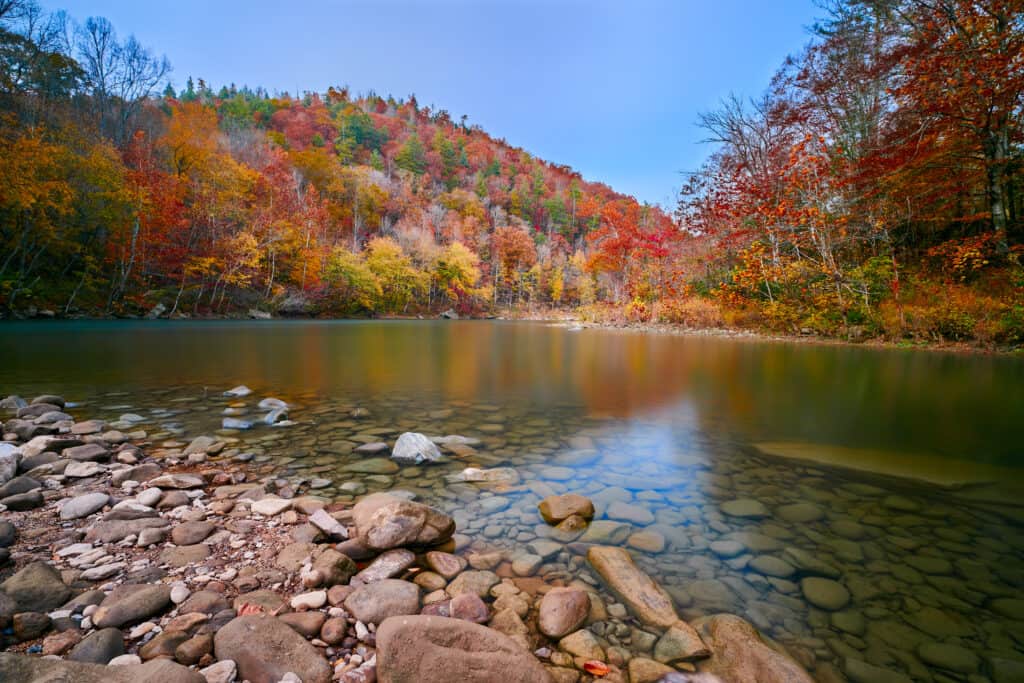
The Cumberland River Basin is one of the
most snake-infested rivers
in the United States.
©Patrick Jennings/Shutterstock.com
Pursuing a similar path, the Cumberland River takes second place on our list, extending over 688 miles long. It meanders through the western region, ultimately converging with the Ohio River in the vicinity of Paducah. Most of the Cumberland River basin is located in rural regions, making it a great place for wildlife to flourish. Various snake species live in and around the Cumberland River, including northern water snakes, midland water snakes, copper-bellied water snakes, broad-banded water snakes, plain-bellied water snakes, cottonmouths, timber rattlesnakes, and eastern ribbon snakes.
2. The Ohio River

The Ohio River is the largest tributary of the Mississippi River.
©Corey B Stevens/Shutterstock.com
Spanning an impressive distance of 981 miles, the Ohio River gracefully delineates the state’s northern boundary, eventually joining forces with the mighty Mississippi River. With its impressive length ranking third among all rivers in the United States, this majestic waterway holds the distinction of being the largest tributary of the Mississippi River. Spanning across a vast drainage area of 205,000 square miles, it provides a thriving habitat for many diverse species. Some of the more common snake species found along the Ohio River are the northern water snake, the common water snake, and the common garter snake. These snakes are all non-venomous and are often found basking on rocks or logs along the riverbank.
3. The Kentucky River

The most popular river in Kentucky is the Kentucky River.
©Patrick Jennings/Shutterstock.com
Lastly, we encounter the Kentucky River, proudly standing as one of the state’s longest rivers. It winds for 267 miles through the central portion of the land, finding its confluence alongside the Ohio River near Louisville. The Kentucky River is also the most popular in Kentucky. The river and its tributaries drain the regions of central Kentucky, passing through the Cumberland Mountains and the Bluegrass region. Some of the snakes you might see in and around the Kentucky River Basin are northern water snakes, plain-bellied water snakes, cottonmouths, timber rattlesnakes, and eastern ribbon snakes.
4. Licking River

The Licking River Basin is found in central Kentucky.
©Patrick Jennings/iStock via Getty Images
Measuring 303 miles long, the Licking River is a tributary of the Ohio River. Nestled in the heart of Kentucky, the Licking River Basin encompasses the central and northeastern regions of this beautiful state. It spans an impressive 4,500 square miles and is home to a variety of plant and animal life. Water snakes are a familiar sight in the Licking River basin, coexisting with garter snakes, rat snakes, and vibrant eastern milksnakes. And while the mesmerizing hues of the eastern milksnakes might give off an intimidating vibe, fear not! These fascinating creatures are completely harmless, adding a touch of beauty to their surroundings.
Visiting Snake-Infested Rivers in Kentucky
Encountering snakes, both venomous and non-venomous, is not limited to Kentucky rivers alone. These remarkable reptiles inhabit diverse habitats, from forests and fields to residential areas. It is crucial for residents residing in snake-prone river regions to embrace a deep understanding and mutual respect for coexisting with these fascinating creatures.
The frequency of snake bite incidents in any area can be influenced by multiple factors, including weather conditions, outdoor activities, and snake behavior. But, fear not, my friends, for the eastern garter snake (Thamnophis sirtalis) — a snake that is not harmful to humans — proudly claims the title of the most frequently spotted snake in Kentucky.
Acquiring knowledge on identifying and safely interacting with a wide array of species can not only save time but also prevent unnecessary suffering. This includes being aware of and knowledgeable about various types of snakes, both venomous and non-venomous. In Kentucky, where 33 snake species have been documented, it is crucial to note that four of them are venomous.
The copperhead, cottonmouth, timber rattlesnake, and pigmy rattlesnake are venomous reptile species that, if not promptly and properly addressed, can result in severe injury or even fatality. It is crucial to handle these situations with utmost care and urgency.
Tips For Mitigating Your Snake-Bite Risk
| Tip | Description |
|---|---|
| Wear long pants and boots | This will help protect your legs and feet from snake bites. |
| Refrain from reaching into concealed spaces | Snakes frequently seek refuge in various areas, including beneath rocks, logs, and amid fallen leaves. |
| Maintain a safe distance from snakes | When a snake, it is important to refrain from approaching it. Instead, provide the snake with ample space to retreat without any disturbance. |
| Use a walking stick | Use a walking stick to tap ahead of you, creating noise and providing snakes an opportunity to move away. |
| Stay on trails | Steer clear of traversing through tall grass or dense foliage, as such areas are prone to housing lurking snakes. |
| Hike with a friend | If you happen to be bitten, having someone nearby can provide assistance and support. |
| Teach children about snakes and how to avoid them | It is crucial to educate children about snakes and instill in them the knowledge of how to avoid encounters with these creatures. |
Common Snakes Found in Kentucky’s Rivers
Here are some of the more common snakes you might encounter in Kentucky’s snake-infested rivers:
1. Northern Water Snake (Nerodia sipedon)
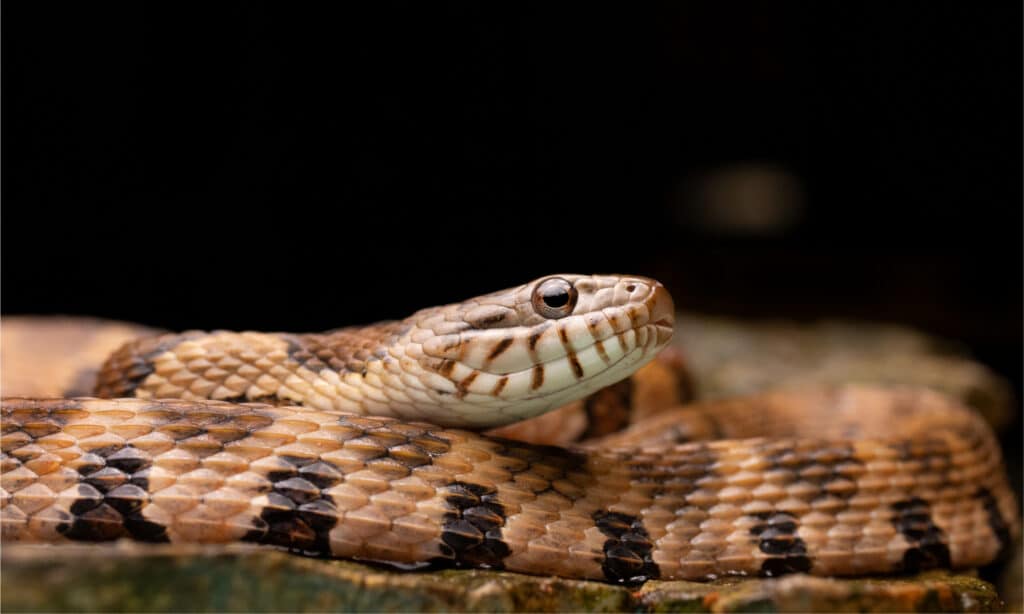
Northern water snakes are often active during the day and often bask near the water’s edge.
©Radiant Reptilia/Shutterstock.com
The northern water snake is a nonvenomous aquatic snake in diverse regions across the eastern and central United States, including Kentucky. Northern water snakes are medium-sized snakes, typically ranging from 24 to 42 inches in length, although some individuals can grow larger. They have a heavy bodies with keeled scales and are usually brown or gray with a series of dark bands or blotches down their back.
In Kentucky, you can often find northern water snakes in or near the many rivers, lakes, and wetland areas that are part of the state’s diverse ecosystem. They are excellent swimmers and are known for their ability to hunt in water, preying on fish, amphibians, and aquatic invertebrates. When disturbed, they may quickly dive into the water to escape from potential threats. Despite their non-venomous nature, they can be quite defensive and may strike or release a foul-smelling musk if handled.
2. Common Garter Snake (Thamnophis sirtalis)
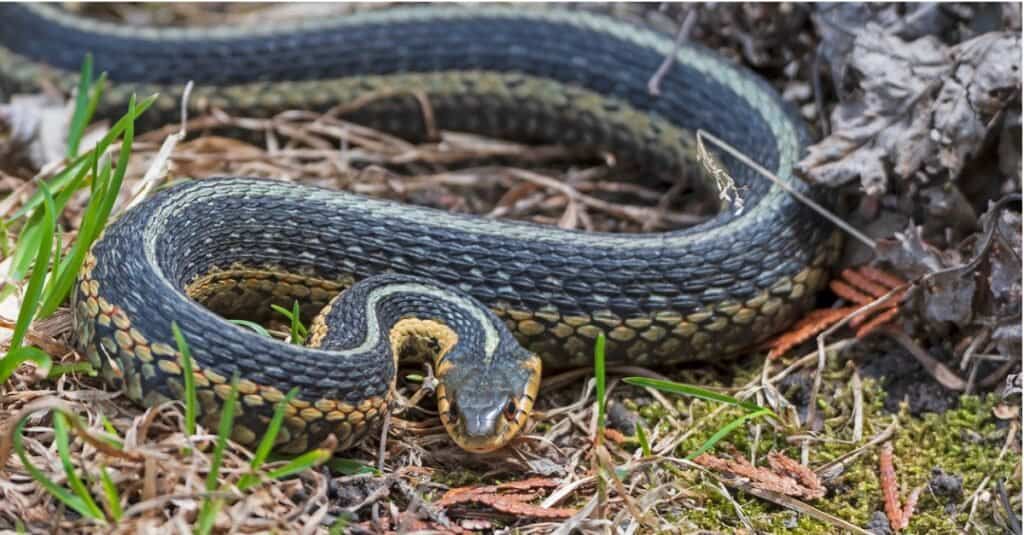
All garter snakes have keeled scales, which means they have a ridge down the center.
©iStock.com/Wildnerdpix
One of the most common snakes in Kentucky is the common garter snake. It lives anywhere from wetlands and forests to urban areas and parks. These snakes are typically 18 to 26 inches long, with variations of black, brown, or green. They are adorned with a yellow or whitish stripe down the center of their bodies. Common garter snakes do not pose any threat to humans. They are excellent swimmers, so they are commonly seen in or near water.
3. Gray Rat Snake (Pantherophis spiloides)

Gray rat snakes retain most of their juvenile pattern as adults.
©Jay Ondreicka/Shutterstock.com
One of the most impressive snakes in Kentucky has to be the gray rat snake. These magnificent creatures can reach lengths of 4 to 6 feet. And there are even reports of some growing up to a staggering 8 feet long! Their coloration is usually a striking mix of gray or black, with distinctive blotches or bands adding to their charm. What makes gray rat snakes even more fascinating is their ability to climb with ease. You’ll often find them gracefully navigating the trees, making their presence known in the world above. And if that wasn’t enough, they are also incredible swimmers, frequently seen near bodies of water.
4. Water Moccasin or Cottonmouth (Agkistrodon piscivorus)
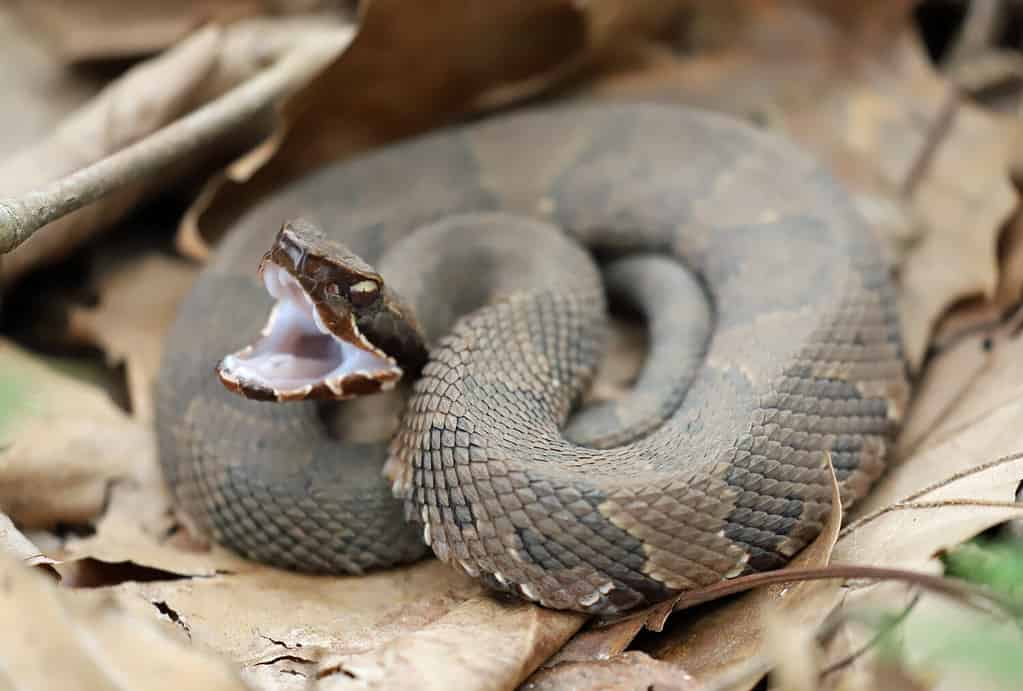
Cottonmouth snakes are commonly found in slow-moving rivers and streams as well as in marshes and swamps.
©KF2017/Shutterstock.com
Also known as water moccasins, cottonmouth snakes are large and dark creatures. They possess triangular-shaped heads and a remarkable feature — the white lining inside their mouths. These mesmerizing snakes are typically shy and tend to avoid human interaction. However, when they feel threatened, a unique warning sign emerges — they open their mouths, exposing that distinctive white lining. Occasionally, if cornered, they may even strike. The venom they inject is a form of potent neurotoxin. This is capable of causing pain, swelling, and the disturbing struggle to breathe. In rare cases, it can even prove fatal. If unfortunate enough to be bitten by a cottonmouth, it is of utmost importance to promptly seek immediate medical attention.
5. Plain-Bellied Water Snake (Nerodia erythrogaster flavigaster)
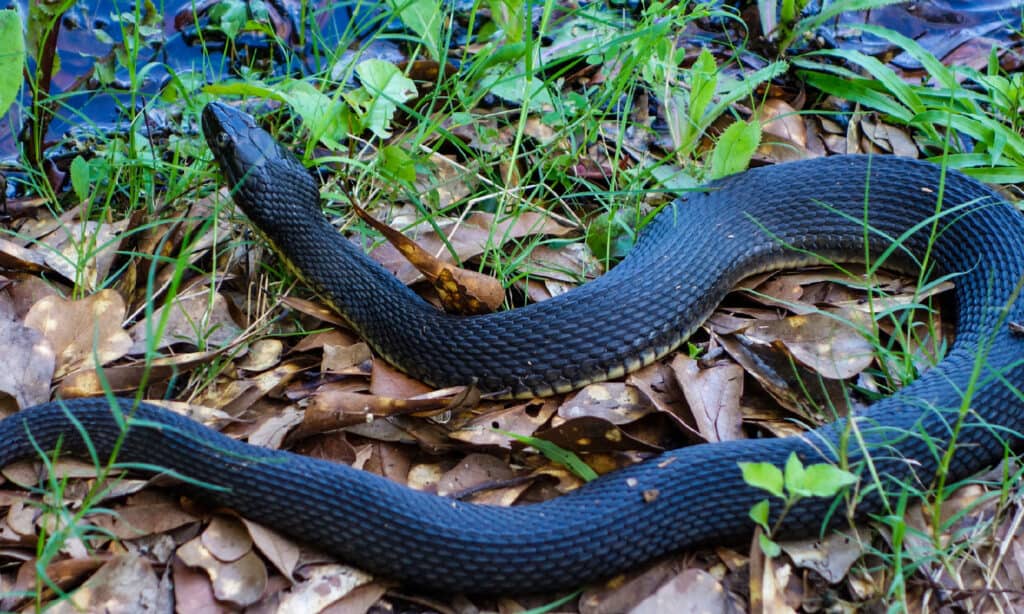
Plain-bellied water snakes have dark backs and yellow or orange bellies.
©iStock.com/Alex Pankratov
Kentucky’s rivers are teeming with various species of water snakes, each with its unique beauty. Among them is the plain-bellied water snake, a smaller but fascinating creature that calls the western part of Kentucky its home. With a body of gray or brown hues and a striking yellow belly, it captivates the eye. Plain-bellied water snakes are commonly found near and in water, where they eat frogs, salamanders, and fish. They are not venomous, but they will strike and bite if they feel threatened.
Summary of the Most Snake-Infested Rivers in Kentucky
| River | Common Snakes |
|---|---|
| Cumberland River | Northern water snakes, midland water snakes, copper-bellied water snakes, broad-banded water snakes, plain-bellied water snakes, cottonmouths, timber rattlesnakes, and eastern ribbon snakes. |
| Ohio River | Northern water snake, the common water snake, and the common garter snake. |
| Kentucky River | Northern water snakes, plain-bellied water snakes, cottonmouths, timber rattlesnakes, and eastern ribbon snakes. |
| Licking River | Water snakes, garter snakes, rat snakes, and vibrant eastern milksnakes. |
The photo featured at the top of this post is © Mrherbalwarrior / Creative Commons – License / Original
Thank you for reading! Have some feedback for us? Contact the AZ Animals editorial team.







